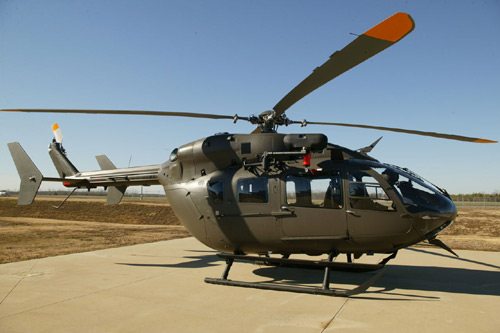The Maryland Army National Guard unveiled its first of four UH-72A Lakota helicopters, April 18. The aircraft will replace the older OH-58A Kiowa as their premier aircraft for civil support, search and rescue and homeland security missions.
The Lakota is actually replacing the aging Kiowa aircraft as well as UH-1 Iroquois “Huey” aircraft, nationwide, within Army National Guard units. The Army plans to purchase a total of 345 Lakota aircraft through 2015. About one third of those will go to active-duty units; the rest go to National Guard units, such as in Maryland.
As of April 5, the Army had taken delivery of 209 Lakotas. They’re being flown in 42 of the 50 states and have logged about 100,000 flight hours so far.
Currently, the Maryland Army Guard has six personnel being trained on the new light utility helicopter and the “security and support” mission equipment package that it carries. According to Guard officials, the S&S version of the Lakota brings to the table many improvements over the Kiowa aircraft it will replace.
The new aircraft includes a nose-mounted center-line payload with infrared and electro-optical sensors and laser painter, which will allow for more accurate search and rescue by using heat signatures. Inside the aircraft, improvements include moving map and touch-screen displays, as well as a video management system. Additional avionics and communications equipment aboard the aircraft include radios that will allow Guard members to communicate with civilian law enforcement personnel and first responders.
Outside the aircraft, to enhance search and rescue capability, the Lakota includes a 30-million candlepower searchlight and an external hoist to allow the aircraft to move up to 600 pounds of equipment.
Compared to the Kiowa, which is a single-engine helicopter, the Lakota has twin-engines. During hurricane season, the increased capability will allow Maryland Guard pilots to fly and take off in winds up to 50 knots, about 60 mph. That capability was not available on the Kiowa.
“It’s a state-of-the-art aircraft for state-of-the-art pilots,” said Maj. Gen. James Adkins, the adjutant general for the Maryland National Guard.
The Lakota is also a more cost-efficient tool. According to Army aviation officials, the Lakota delivers cost savings on maintenance. As a light utility helicopter, the Lakota was pursued as a replacement for the Kiowa as well as the “Huey.” Repair parts for the Lakota are less expensive than for the older aircraft, and are delivered more quickly.
In Maryland, the Army National Guard unit there was also using the UH-60 Black Hawk to do some missions, due to its capability over the Kiowa. The Kiowa, for instance, didn’t have hoist capability so the Black Hawk provided that function. But now the Lakota will do that job, and Maryland Guard officials say the new aircraft can be maintained and operated at half the cost of the Black Hawk.
Additionally, Army-wide, the Lakota has maintained 90 percent operational availability rates, officials said.
With all of the upgrades the Lakota brings to the Maryland Army Guard fleet, Adkins feels this will position them to be even more efficient for multiple missions.
“Not only does it help Maryland by replacing older aircraft, but it supports the governor in emergencies and it supports the federal government as well,” he said.
“Two of these aircraft will be going to the southwest border at the beginning of June to support U.S. Customs down there,” Adkins said. “We’ll use it in state emergencies whether we need to go out and look for lost individuals, or do analysis of the impact of a hurricane.”
Chief Warrant Officer 2 Renonzo Belcher, a Lakota pilot and a Baltimore police flight officer, was one of the pilots for Wednesday’s flight. He feels that even though the Kiowa was a useful tool for the Maryland Guard, he is looking forward to the capabilities the Lakota will bring to the fleet.
“The old [helicopter] was good, but this one has a lot more capabilities,” he said. “[The Lakota has] a lot more radios, a little bit more power so that we can also conduct hoist missions [and] carry a lot more people and we’re able to stay up in the air lot longer. Versus the older plane, where two hours of flight-time was feasible, the new Lakota can offer us three to three-and-a-half hours.”










